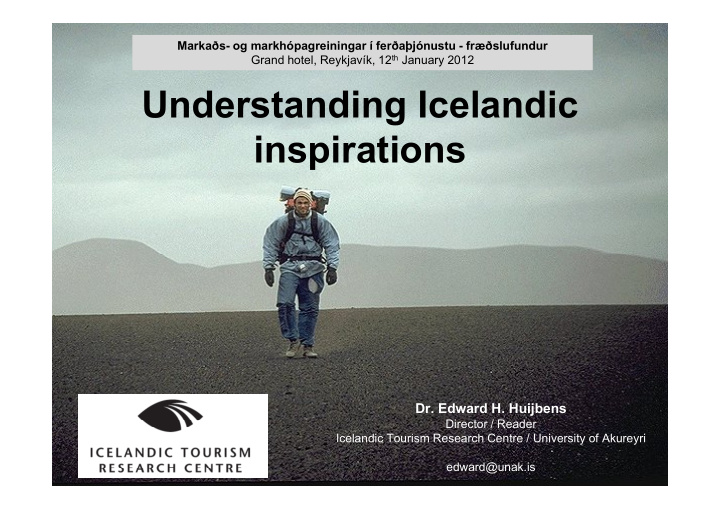



Markaðs- og markhópagreiningar í ferðaþjónustu - fræðslufundur Grand hotel, Reykjavík, 12 th January 2012 Understanding Icelandic i inspirations i ti Dr. Edward H. Huijbens Director / Reader Director / Reader Icelandic Tourism Research Centre / University of Akureyri edward@unak.is
Basic tourism marketing segmentations • Geographic – finding out where people live • Buyer characteristics y – Demographic – age, sex and family status – Economic (price sensitivities) (p ) • Purpose of travel – Business versus leisure travellers Business versus leisure travellers • Frequent versus infrequent travellers • Independent tourists versus organized groups I d d t t i t i d • Psychographic – Needs, motivations and benefits sought
Psychographic segmentation • Social class • Lifestyles Lifestyles • Personality • How tourists make purchase decisions p – Psychographic make up • Who makes the decision • When is the decision made – Extensive, limited, routinized or impulsive? • How do they perceive Iceland
Emerging types Emerging types Cohen (1972) Cohen (1972) Plog (1977) Plog (1977) Cohen (1979) Cohen (1979) Belgian survey (1986) Belgian survey (1986) Perrea lt Dorden and Dorden (1979) Perreault, Dorden and Dorden (1979) The organized mass tourist Psychocentric homebody Recreational tourist Traditionalists The individual mass tourist vacationers Diversionary tourists Family - sun, sand sea lovers The explorer budget travellers Experiential tourist Discoverers The drifter Allocentric moderates Experimental tourist Nature viewers adventurous Existential tourist Contact minded Active sea lovers Dalen (1989) Smith (1989) Wood and House (1991) Wickens (1994) Gallup and American Express (1989) Traditional materialists Indulgers Charter Bad tourist Lord Byrons Traditional idealists Worriers Mass Heliolatrus Modern materialists Modern materialists Economizers Economizers Incipient Incipient Shirley Valentines Shirley Valentines Modern idealists Dreamers Unusual Good tourist Ravers Adventurers Off-beat Cultural heritage Elite Explorers Based on: Swarbrooke and Horner 2007: Consumer Behaviour in Tourism , pp. 83-89
ArkLeisure segements ArkLeisure segements From: http://www.arkleisure.co.uk/explore/, viewed 6th January 2012
EQ segments EQ segments From: http://en-corporate.canada.travel/resources-industry/toolkits/eq-teaser, viewed 10th January 2012
Basic points to bear in mind however ... • Beware of stereotyping • Personal progression through types Personal progression through types • The autonomy of the individual in decision making is never complete ki i l t • Professed preferences and actual o essed p e e e ces a d actua behaviour? • The business tourist? The b siness to rist? • Eurocentric and outdated (Web 2.0) ( )
Emerging types Emerging types Cohen (1972) Cohen (1972) Plog (1977) Plog (1977) Cohen (1979) Cohen (1979) Belgian survey (1986) Belgian survey (1986) Perrea lt Dorden and Dorden (1979) Perreault, Dorden and Dorden (1979) The organized mass tourist Psychocentric homebody Recreational tourist Traditionalists The individual mass tourist vacationers Diversionary tourists Family - sun, sand sea lovers The explorer budget travellers Experiential tourist Discoverers The drifter Allocentric moderates Experimental tourist Nature viewers adventurous Existential tourist Contact minded Active sea lovers Dalen (1989) Dalen (1989) Smith (1989) Smith (1989) Wood and House (1991) Wood and House (1991) Wickens (1994) Wickens (1994) Gallup and American Express (1989) Gallup and American Express (1989) Traditional materialists Indulgers Charter Bad tourist Lord Byrons Traditional idealists Worriers Mass Heliolatrus Modern materialists Economizers Incipient Shirley Valentines Modern idealists Dreamers Unusual Good tourist Ravers Adventurers Off-beat Cultural heritage Elite Explorers U Urry (2002) (2002) The post tourist Based on: Swarbrooke and Horner 2007: Consumer Behaviour in Tourism , pp. 83-89
Post tourist? Post tourist? … what was once different is now familiar and what was once different is now familiar and the necessity to travel to encounter difference is greatly diminished as the experience of foreign cultures practices tastes and fashions become cultures, practices, tastes and fashions become routinely embedded in everyone‘s daily lives. Williams, 2009: Tourism Geography. A New Synthesis , p. 6 … “rigorous”, “full of facts”, and “concrete details” but also “literary” details but also literary , evocative , “evocative” “engaging”, “imaginative”, “accessible” and full of “flesh and blood emotions” and “feelings” … feelings … Crang og Cook, 2007: Doing Ethnographies , p. 205 Án áfangstaðar/Without Destination
Humans, their desires and plans, are clearly not the only things active in the world the only things active in the world Anderson and Harrison, 2010: Taking Place. Non-Representational theories and Geography , p. 12 Kristján Pétur Sigurðsson, 2010: Rauðaþögn á ferð og flugi – Café Karólína, 3rd-30th April 2010 future studies should focus on the nature of the relations between the objects future studies should focus on the nature of the relations between the objects and the subjects that constitute the tourist experience Uriely, 2005: The Tourist Experience, p. 212
The art of E15 The art of E15 ... þá er þetta samtal við fólk um sömu minningarnar og þá verða þessir þ þ g g þ þ tímapollar til þar sem að tíminn á sér einhvern poll sem verður eftir þegar tíminn flæðir yfir og er farin þá sitja eftir kannski nokkrir pollar og það er þar sem að þetta ... Þetta eru ekki beint minningar, en þetta er sko sameiginleg reynsla þannig að fólk veit um hvað maður er að tala ... Vignir Jóhannsson, 2012: Fjallar um glerlistaverk sín á Kastrup með ösku úr Eyjafjallajökli, Kastljós, 2. janúar Vignir Jóhannsson, 2011: http://www.vignirjohannsson.is/#
Recommend
More recommend